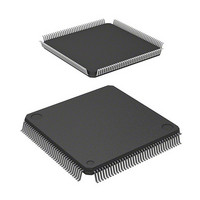HD6417708SF60 Renesas Electronics America, HD6417708SF60 Datasheet - Page 250

HD6417708SF60
Manufacturer Part Number
HD6417708SF60
Description
IC SUPERH MPU ROMLESS 144LQFP
Manufacturer
Renesas Electronics America
Series
SuperH® SH7700r
Datasheet
1.HD6417708SF60V.pdf
(635 pages)
Specifications of HD6417708SF60
Core Processor
SH-2
Core Size
32-Bit
Speed
60MHz
Connectivity
EBI/EMI, SCI, SmartCard
Peripherals
POR, WDT
Number Of I /o
8
Program Memory Type
ROMless
Voltage - Supply (vcc/vdd)
3 V ~ 3.6 V
Oscillator Type
External
Operating Temperature
-20°C ~ 75°C
Package / Case
144-LQFP
Lead Free Status / RoHS Status
Contains lead / RoHS non-compliant
Eeprom Size
-
Ram Size
-
Program Memory Size
-
Data Converters
-
Available stocks
Company
Part Number
Manufacturer
Quantity
Price
Company:
Part Number:
HD6417708SF60
Manufacturer:
HITACHI
Quantity:
2 400
Company:
Part Number:
HD6417708SF60
Manufacturer:
Renesas Electronics America
Quantity:
10 000
Company:
Part Number:
HD6417708SF60I
Manufacturer:
ACCMICRO
Quantity:
144
Company:
Part Number:
HD6417708SF60V
Manufacturer:
Renesas Electronics America
Quantity:
10 000
Part Number:
HD6417708SF60V
Manufacturer:
RENESAS/瑞萨
Quantity:
20 000
- Current page: 250 of 635
- Download datasheet (3Mb)
When synchronous DRAM is connected, the RAS signal, CAS signal, RD/WR signal, and byte
control signals DQMHH, DQMHL, DQMLH, and DQMLL are all asserted and addresses
multiplexed. Control of RAS, CAS, data timing, and address multiplexing is set with MCR.
When DRAM is connected, the RAS2 signal, CAS2H signal, CAS2L signal, and RD/WR signal
are all asserted and addresses multiplexed. Control of RAS2, CAS, data timing, and address
multiplexing is set with DCR.
Area 3: Area 3 physical address bits A28–A26 are 011. Address bits A31–A29 are ignored and
the address range is H'0C000000 + H'20000000
n – H'0FFFFFFF + H'20000000 n (n = 0–6, n
= 1–6 is the shadow space).
Normal memories like SRAM and ROM, as well as DRAM, pseudo-SRAM, and synchronous
DRAM, can be connected to this space. Byte, word or longword can be selected as the bus width
using the A3SZ1–A3SZ0 bits in BCR2 for normal memory. For DRAM and pseudo-SRAM, word
or longword can be selected using the SZ bit in MCR. When synchronous DRAM is connected,
set to longword using the SZ bit in MCR.
When area 3 space is accessed, CS3 is asserted.
When normal memories are connected, the RD signal that can be used as OE and the WE0–WE3
signals for write control are asserted and the number of bus cycles is selected between 0 and 3 wait
cycles using the A3W1–A3W0 bits in WCR2. When normal memory is connected, only, any
number of waits can be inserted in each bus cycle by means of the external wait pin (WAIT).
When synchronous DRAM is connected, the RAS signal, CAS signal, RD/WR signal, and byte
control signals DQMHH, DQMHL, DQMLH, and DQMLL are all asserted and addresses
multiplexed. When DRAM is connected, the RAS signal, CASHH signal, CASHL signal, CASLH
signal, CASLL signal, and RD/WR signal are all asserted and addresses multiplexed. When
pseudo-SRAM is connected, the CE signal, OE/RFSH signal, and WE0, WE1, WE2, and WE3
signals are asserted. For all of these, control of RAS , CAS , and data timing and of address
multiplexing is set with MCR.
Area 4: Area 4 physical address bits A28–A26 are 100. Address bits A31–A29 are ignored and
the address range is H'10000000 + H'20000000 n – H'13FFFFFF + H'20000000 n (n = 0–6, n
= 1–6 is the shadow space).
Only normal memories like SRAM and ROM can be connected to this space. Byte, word, or
longword can be selected as the bus width using the A4SZ1–A4SZ0 bits in BCR2. When the area
4 space is accessed, the CS4 signal is asserted. The RD signal that can be used as OE and the
WE0–WE3 signals for write control are also asserted. The number of bus cycles is selected
between 0 and 10 wait cycles using the A4W2–A4W0 bits in WCR2. Also, any number of waits
can be inserted in each bus cycle by means of the external wait pin (WAIT).
230
Related parts for HD6417708SF60
Image
Part Number
Description
Manufacturer
Datasheet
Request
R

Part Number:
Description:
KIT STARTER FOR M16C/29
Manufacturer:
Renesas Electronics America
Datasheet:

Part Number:
Description:
KIT STARTER FOR R8C/2D
Manufacturer:
Renesas Electronics America
Datasheet:

Part Number:
Description:
R0K33062P STARTER KIT
Manufacturer:
Renesas Electronics America
Datasheet:

Part Number:
Description:
KIT STARTER FOR R8C/23 E8A
Manufacturer:
Renesas Electronics America
Datasheet:

Part Number:
Description:
KIT STARTER FOR R8C/25
Manufacturer:
Renesas Electronics America
Datasheet:

Part Number:
Description:
KIT STARTER H8S2456 SHARPE DSPLY
Manufacturer:
Renesas Electronics America
Datasheet:

Part Number:
Description:
KIT STARTER FOR R8C38C
Manufacturer:
Renesas Electronics America
Datasheet:

Part Number:
Description:
KIT STARTER FOR R8C35C
Manufacturer:
Renesas Electronics America
Datasheet:

Part Number:
Description:
KIT STARTER FOR R8CL3AC+LCD APPS
Manufacturer:
Renesas Electronics America
Datasheet:

Part Number:
Description:
KIT STARTER FOR RX610
Manufacturer:
Renesas Electronics America
Datasheet:

Part Number:
Description:
KIT STARTER FOR R32C/118
Manufacturer:
Renesas Electronics America
Datasheet:

Part Number:
Description:
KIT DEV RSK-R8C/26-29
Manufacturer:
Renesas Electronics America
Datasheet:

Part Number:
Description:
KIT STARTER FOR SH7124
Manufacturer:
Renesas Electronics America
Datasheet:

Part Number:
Description:
KIT STARTER FOR H8SX/1622
Manufacturer:
Renesas Electronics America
Datasheet:

Part Number:
Description:
KIT DEV FOR SH7203
Manufacturer:
Renesas Electronics America
Datasheet:











